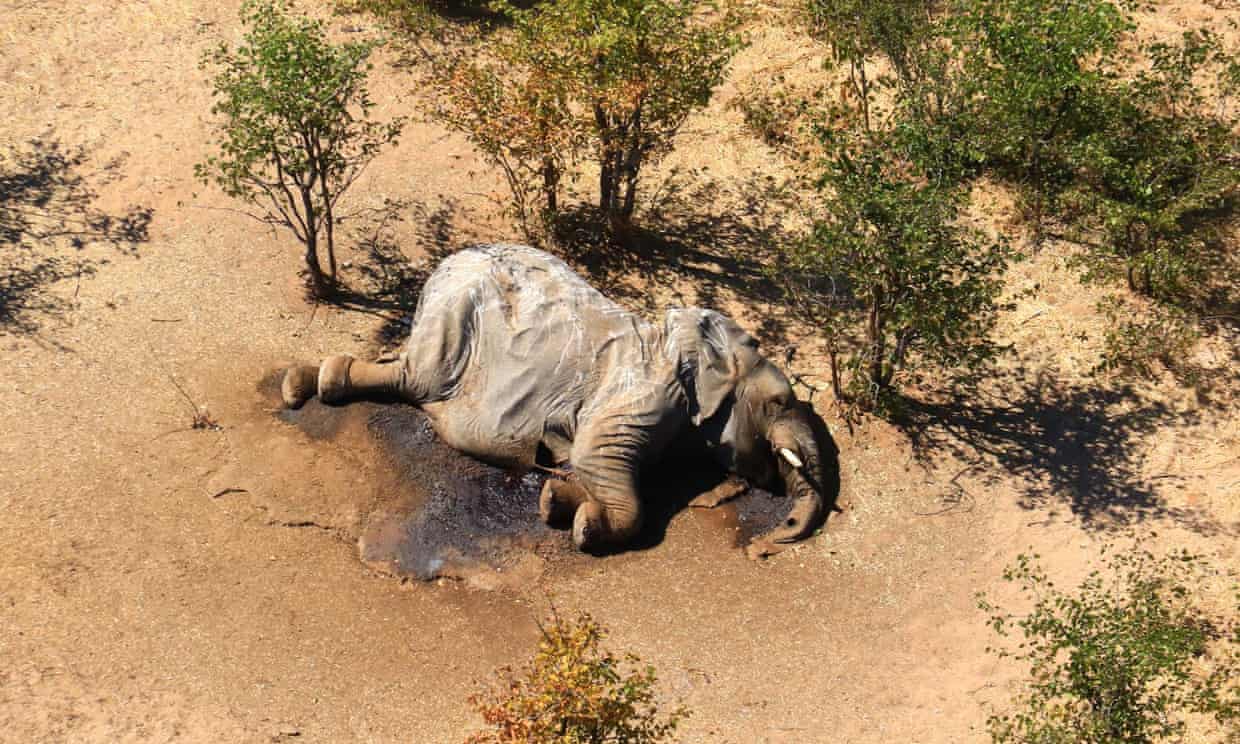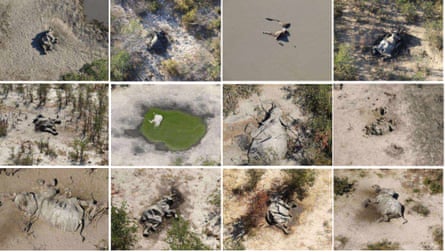The 35 elephants that dropped dead in Zimbabwe were victims of an obscure bacteria combined with extreme heat, and more elephants – and other species – could suffer the same fate
Elephants that dropped dead in Zimbabwe were victims of an obscure bacteria combined with extreme heat. Scientists fear more elephants – and other species – could suffer the same fate

An elephant carcass in Botswana – one of hundreds that died mysteriously. Scientists are racing to stay ahead of emerging threats to their health. Photograph: National Park Rescue/AFP/Getty Images
The first elephant to die was an eight-year-old male. It was found on 24 August 2020 on the southern border of Panda Masuie forest reserve, Zimbabwe, collapsed on its side like a grey marquee in the reddish dirt.
When Dr Chris Foggin, a wildlife veterinarian at the Victoria Falls Wildlife Trust, went to examine it, his first guess was anthrax – a common killer at that time of year. He was cautious taking organ samples, and burned the carcass when he had finished.
But over the next two days, another 10 dead elephants were found: many of them young, all within a couple of kilometres. Usually anthrax causes individual deaths, widely scattered. The number of carcasses grew to 35, with concerns that others were yet to be found. Just two months earlier, 350 elephants had dropped dead in the Okavango delta in Botswana, and speculation grew as to what was happening.
Three years later, the results of Foggin’s initial tests have been published, finally unravelling the mystery of Zimbabwe’s elephant mortalities. The culprit: Pasteurella Bisgaard taxon 45, an obscure bacteria not known to kill elephants. Its discovery adds to the list of threats facing endangered African savanna elephants, researchers warn – but it could also have wider implications. In heatwave conditions, similar bacteria have made the leap into the bloodstream in antelope, causing mass deaths. As the planet heats and hot, dry conditions become more common, scientists are concerned this could happen in other species, and are calling for more testing to establish the scale of the threat.
Solving the elephant mystery
Discovering what causes mass deaths in savanna wildlife is hugely challenging – an under-resourced race against time, distance and heat.
An elephant postmortem is an enormous undertaking: peeling off the skin, breaking into the ribs and brain with an axe, and extracting samples of key organs. The whole process takes a team of people four hours and it has to be done within a day of the elephant dying, before the heat begins to break the body down, which is why so few postmortems were carried out on the stricken animals.
Foggin sent samples to international labs with facilities to do comprehensive tests on this unidentifiable disease. They eventually diagnosed Pasteurella Bisgaard taxon 45, which had resulted in septicaemia, or blood poisoning. Foggin says it mainly killed younger, weaned elephants, as they tend to be under more stress, walking great distances to reach water. There had been two poor rainy seasons in a row and drought conditions when the deaths occurred.

“That age group are most stressed under these environmental conditions and probably most susceptible to a septicemic infection,” he says. As the planet heats, temperatures warm, and drought conditions become more frequent, elephants will be in stressed conditions more frequently, making outbreaks more likely.
“The most worrying thing is that we believe Pasteurella Bisgaard taxon 45 might have the potential to kill a large number of elephants,” Foggin says.
Alarming, too, was how little the scientists knew of Pasteurella Bisgaard taxon 45, and how often it had killed before. “We don’t know at this stage why it appeared and disappeared when it did,” Foggin says.
‘We may see other unexpected deaths’
There is a precedent for this. A Pasteurella bacterium was linked to the sudden death of more than 200,000 saiga antelopes in Kazakhstan in 2015. Dr Arnoud van Vliet from the University of Surrey says his analysis of the Zimbabwe strain showed that it was very similar to the bacterium that killed the saiga antelope. “It’s thought to be sufficiently unique, but it shares a lot of components to the antelope one,” he says.
The Pasteurella bacteria are believed to live harmlessly in the tonsils of some, if not all, of the antelopes, as well as species including tigers, lions and chipmunks. In the antelopes, an outside temperature increase to 37C caused the bacteria to pass into the bloodstream, where it caused septicaemia. “It is still a guess, but I imagine that a similar thing happened with the elephants,” says Van Vliet.
He believes the Pasteurella bacterium may go beyond elephants and antelope, because genetically these animals are very distinct, but it appears to kill both of them. “There may be other animals where this could become a problem,” he says. “If we don’t look for it, we won’t know whether it is there. If it is present in other wildlife, we may see other unexpected deaths.”

A race against time
As global temperatures increase, researchers believe understanding this Pasteurella bacterium is more pressing than ever. African savanna elephants are endangered, with 350,000 remaining, and the population declining by 8% a year. “We’d like to take this research further,” says Van Vliet, but there is no funding to do so.
Not only is it a race against the clock to get to the carcasses quickly enough, it is not easy getting bacterial samples to the right laboratories, and getting permits sorted. “These kinds of projects are horrendously expensive to do,” Van Vliet says.
Victoria Falls Wildlife Trust in Zimbabwe is now able to test for Pasteurella Bisgaard taxon 45, so won’t have to rely on laboratories in other countries for help. If it returns, veterinarians will be able to identify it quickly. But that capacity is not yet widespread.
In 2022, researchers carrying out the annual elephant survey in the Kavango-Zambezi conservation area – which includes the Panda Masuie reserve and the Okavango delta – found a high number of recent carcasses. It is not known whether Bisgaard taxon 45 may have caused some of them, but it should now be on the list of things to investigate in the case of sudden death in African elephants, Zimbabwe-based epidemiologist Laura Ronsen wrote in a recent blog post.
Van Vliet agrees. “When there’s next a mass extinction, or unexpected deaths of elephants, I would definitely say this is something to look for”
The post It took years to solve the mystery elephant deaths. Now, the threat is spreading appeared first on Zimbabwe Situation.
